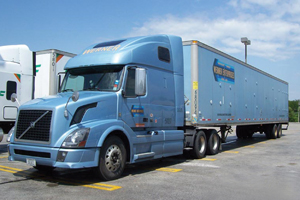March Tonnage Rises 3.1%

This story appears in the April 28 print edition of Transport Topics.
Truck tonnage rose 3.1% in March from a year earlier despite residual problems with harsh winter weather, American Trucking Associations reported, buoying hopes of a stronger trucking market.
“Despite the fact that tonnage hasn’t snapped back to the levels we saw late last year, the fundamentals for truck freight continue to look good,” said ATA Senior Economic Bob Costello, referring to the record mark set in November.
“While it will take time to regain what was lost due to weather and other factors, like a potential inventory correction in the first quarter, I remain optimistic for 2014,” he said.
Last month’s result was the best year-over-year performance of 2014. For the first quarter, tonnage improved 2.3% over 2013 in the face of winter weather east of the Rocky Mountains that was among the worst in U.S. history. Tonnage for the quarter was down from the fourth quarter of 2013, in large part because of weather disruptions.
Tonnage is rebounding along with retail sales, which rose 1.1% last month, the fastest pace in 19 months. Other recent favorable indicators were a 0.5% rise in manufacturing output announced by the Federal Reserve and a 0.8% increase in leading indicators compiled by a private group.
ATA’s index reached 127.3 in March compared with a 126.5 in February. The group’s advanced seasonally adjusted index based on for-hire carriers’ freight also increased on a month-to-month basis, rising 0.6% in March over February.
Costello also noted in ATA’s report that tonnage still hasn’t fully recovered from the winter weather effects. And while remaining optimistic for the rest of 2014, the ATA official said he didn’t expect tonnage growth to match last year’s 6.3% pace.
One positive sign was Navistar International Corp.’s April 24 statement that production would be increased in the second half of the year in response to rising demand for Class 8 trucks.
Also last week, truckload carrier Werner Enterprises — which is based in Omaha, Neb., and ranks No. 13 on the Transport Topics list of the 100 largest U.S. and Canadian for-hire carriers — reported its miles operated improved last month as winter subsided. It also said demand during the first quarter for one-way truckload shipments was the strongest in 10 years.
Another strong sign was the Cass Information Systems truck-rate index, which showed a 6% increase last month, the fastest pace in nearly three years.
“Demand for freight transportation continues to improve while capacity shrinks as carriers continue to exit the marketplace,” the April 17 report said.
Likewise, Internet Truckstop’s Trans4Cast report last week also showed increased activity and rates.
“It is unlikely that truck capacity will expand in any meaningful way in the near term,” the report said. “The retail sales report last week was very solid, pointing to an improved outlook for future load availability.”
“The trend line is well above any recent prior year,” said Eileen Hart, a spokeswoman for DAT, a load board operator. “The supply chain disruption is still working its way out of the system after the winter weather.”
As a result, DAT showed a 17% increase in van rates on a year-over-year basis in March, along with a 14% rise in the refrigerated freight sector and a 10% increase for flatbed freight.
Robert Salmon, an analyst at Deutsche Bank, also predicted increased freight volumes, at least through midsummer.
He cited the potential for the increased business as a result of uncertainty among retailers about the outcome of West Coast labor negotiations contract talks that begin next month, barely six weeks before the June 30 contract expiration.
“The current underlying truckload supply-demand dynamics indicate that capacity issues will continue in the foreseeable future,” said a report from Jason Seidl at Cowen and Co. “The rise in freight levels appears sustainable.”
He said capacity will continue to be restrained by the worsening driver shortage and reductions in driving hours as a result of hours-of-service law changes.
Benjamin Hartford of Robert W. Baird & Co. said that “regulatory changes could support a multiyear period of industry consolidation and above-inflation pricing,” helping carriers such as Werner.
ATA’s not-seasonally adjusted index, which gauges freight actually hauled, stood at 129.4 last month, 12.1% above February and 3.4% above last year.
Mark Montague, an industry pricing analyst at DAT, said the strength in the flatbed market indicated that “the energy sector is pushing the economy forward.”
Examples that he cited were increased shipments of machinery and pipes for shale gas exploration that surged even before winter subsided in Houston, which he described as “the linchpin of the energy sector.”
March tonnage also was helped by increased produce shipments across the U.S. border from Mexico at Nogales, Ariz., and McAllen, Texas, as well as a strong growing season in Florida.
California produce shipments so far haven’t been affected too much by the drought, Montague said.
ATA’s February tonnage was revised downward from the earlier preliminary amount.
The change resulted in a 2.7% year-over-year February increase in tonnage from 3.6% reported previously.




